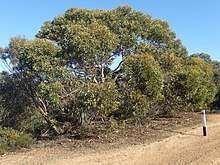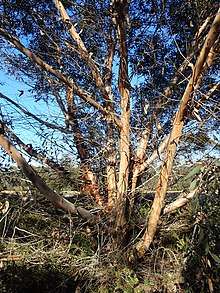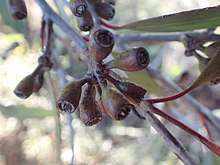Eucalyptus redunca
Eucalyptus redunca, commonly known as black marlock,[2] is a species of mallee or a shrub that is endemic to Western Australia. It has smooth bark, lance-shaped adult leaves, flower buds in groups of between nine and fifteen, lemon-coloured flowers and barrel-shaped fruit.
| Black marlock | |
|---|---|
 | |
| Eucalyptus redunca growing south of Ravensthorpe | |
| Scientific classification | |
| Kingdom: | Plantae |
| Clade: | Tracheophytes |
| Clade: | Angiosperms |
| Clade: | Eudicots |
| Clade: | Rosids |
| Order: | Myrtales |
| Family: | Myrtaceae |
| Genus: | Eucalyptus |
| Species: | E. redunca |
| Binomial name | |
| Eucalyptus redunca | |
| Synonyms[1] | |
|
Eucalyptus redunca Schauer var. redunca | |



Description
Eucalyptus redunca is a mallee that typically grows to a height of 1–4.5 m (3 ft 3 in–14 ft 9 in) and forms a lignotuber. It has grey and pale brown bark that is shed in short ribbons. The adult leaves are narrow-lance-shaped to lance-shaped, 50–75 mm (2.0–3.0 in) long and 9–25 mm (0.35–0.98 in) wide tapering to a petiole 8–15 mm (0.31–0.59 in) long. The flower buds are arranged in leaf axils in groups of between nine and fifteen on an unbranched peduncle 8–15 mm (0.31–0.59 in) long, the individual buds on pedicels 3–5 mm (0.12–0.20 in) long. Mature buds are an elongated spindle shape, 16–26 mm (0.63–1.02 in) long and 3–4 mm (0.12–0.16 in) wide with a conical to horn-shaped operculum that is two or three times as long as the floral cup. Flowering occurs from July to October or November and the flowers are lemon-coloured. The fruit is a woody, barrel-shaped capsule 7–11 mm (0.28–0.43 in) long and 5–8 mm (0.20–0.31 in) wide with the valves near rim level.[2][3][4]
Taxonomy and naming
Eucalyptus redunca was first formally described in 1844 by Johannes Conrad Schauer in 1844 in Johann Georg Christian Lehmann's book Plantae Preissianae.[5][6] The specific epithet (redunca) is from the Latin word reduncus meaning bent backwards, referring to the tip of the operculum that is sometimes bent when young.[7]
Distribution
Black marlock is found on undulating, low ridges mostly along the south coast between Cape Riche and the Fitzgerald River National Park, and inland as far as Ravensthorpe. It grows in shrubland and open woodland in sand-clay soils often over laterite.[2][3][4]
The species is associated with the western mallee subgroup which is characterised by several eucalypts including E. oleosa, E. moderata, E. incrassata, E. foecunda, E. eremophila and E. uncinata. The understorey is predominantly shrubby with species of Melaleuca and Acacia along with the occasional Triodia.[8]
Conservation status
This mallee is classified as "not threatened" by the Western Australian Government Department of Parks and Wildlife.[4]
See also
References
- "Eucalyptus redunca". Australian Plant Census. Retrieved 11 December 2019.
- "Eucalyptus redunca". Euclid: Centre for Australian National Biodiversity Research. Retrieved 29 May 2020.
- Chippendale, George M. "Eucalyptus redunca". Australian Biological Resources Study, Department of the Environment and Energy, Canberra. Retrieved 11 December 2019.
- "Eucalyptus redunca". FloraBase. Western Australian Government Department of Parks and Wildlife.
- "Eucalyptus redunca". APNI. Retrieved 11 December 2019.
- Lehmann, Johann Georg Christian (ed.); Schauer, Johannes Conrad (1844). Plantae Preissianae. Hamburg: Sumptibus Meissneri. pp. 127–128. Retrieved 11 December 2019.CS1 maint: extra text: authors list (link)
- Francis Aubie Sharr (2019). Western Australian Plant Names and their Meanings. Kardinya, Western Australia: Four Gables Press. p. 292. ISBN 9780958034180.
- "Open mallee woodlands and sparse mallee woodlands" (PDF). Commonwealth of Australia. Retrieved 6 May 2017.